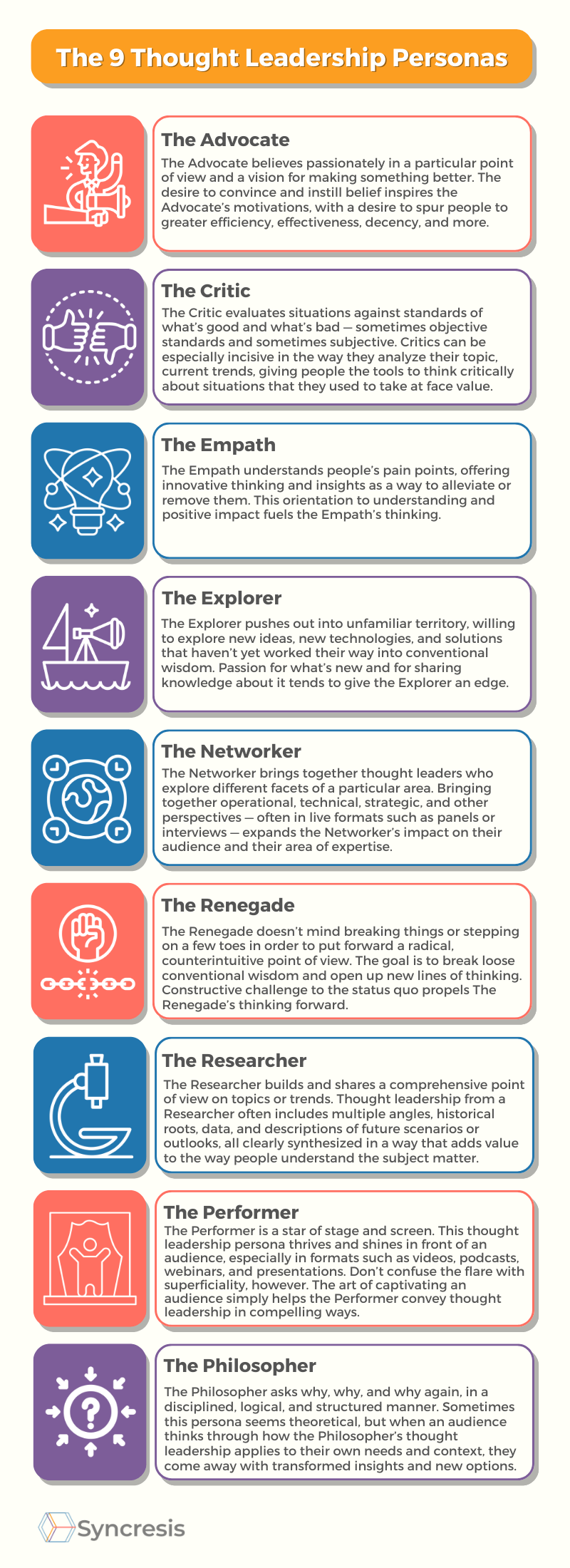Adopting a specific persona can help thought leaders shape both individual pieces of thought leadership and their overarching brand.
Using thought leadership personas with clear intention can help provide a framework for how you communicate in your thought leadership output. Understanding the best persona to get your message across for a particular topic and context makes your approach sharper. It helps you deliver the optimal messages at the right time in the right forum. For example, you might find yourself using one in an opinion piece, another in a blog, a third in a whitepaper, and still a fourth in a live event.
In addition, a thought leader’s work will ultimately create a broad reputation as one of these personas, or a hybrid. As you build up a sustained flow of thought leadership with a good degree of loyalty, this macro-level persona will become part of what people expect when they see your next article or listen to your next podcast. It’s one of many elements that sets you apart.
Whether you are using personas to sharpen your delivery in the moment or building a brand that reflects your deeper personality and the way you choose to show up, these personas can shed some light on the personas. It’s not an exhaustive list, and there are nuances, but like any archetype, each one illustrates essential aspects of much more complex principles.
These personas are neither good nor bad; none is preferable to the others. So, in alphabetical order with some brief definitions, they are:
The Advocate: The Advocate believes passionately in a particular point of view and a vision for making something better. The desire to convince and instill belief inspires the Advocate’s motivations, with a desire to spur people to greater efficiency, effectiveness, decency, and more.
The Critic: The Critic evaluates situations against standards of what’s good and what’s bad — sometimes objective standards and sometimes subjective. Critics can be especially incisive in the way they analyze their topic, current trends, giving people the tools to think critically about situations that they used to take at face value.
The Empath: The Empath understands people’s pain points, offering innovative thinking and insights as a way to alleviate or remove them. This orientation to understanding and positive impact fuels the Empath’s thinking.
The Explorer: The Explorer pushes out into unfamiliar territory, willing to explore new ideas, new technologies, and solutions that haven’t yet worked their way into conventional wisdom. Passion for what’s new and for sharing knowledge about it tends to give the Explorer an edge.
The Networker: The Networker brings together thought leaders who explore different facets of a particular area. Bringing together operational, technical, strategic, and other perspectives — often in live formats such as panels or interviews — expands the Networker’s impact on their audience and their area of expertise.
The Renegade: The Renegade doesn’t mind breaking things or stepping on a few toes in order to put forward a radical, counterintuitive point of view. The goal is to break loose conventional wisdom and open up new lines of thinking. Constructive challenge to the status quo propels The Renegade’s thinking forward.
The Researcher: The Researcher builds and shares a comprehensive point of view on topics or trends. Thought leadership from a Researcher often includes multiple angles, historical roots, data, and descriptions of future scenarios or outlooks, all clearly synthesized in a way that adds value to the way people understand the subject matter.
The Performer: The Performer is a star of stage and screen. This thought leadership persona thrives and shines in front of an audience, especially in formats such as videos, podcasts, webinars, and presentations. Don’t confuse the flare with superficiality, however. The art of captivating an audience simply helps the Performer convey thought leadership in compelling ways.
The Philosopher: The Philosopher asks why, why, and why again, in a disciplined, logical, and structured manner. Sometimes this persona seems theoretical, but when an audience thinks through how the Philosopher’s thought leadership applies to their own needs and context, they come away with transformed insights and new options.
Do any of these personas sound like you? When do you tend to play these roles? I’ll be exploring them, how to adopt them, and how they can shape your brand in more detail over time in future blog posts.





